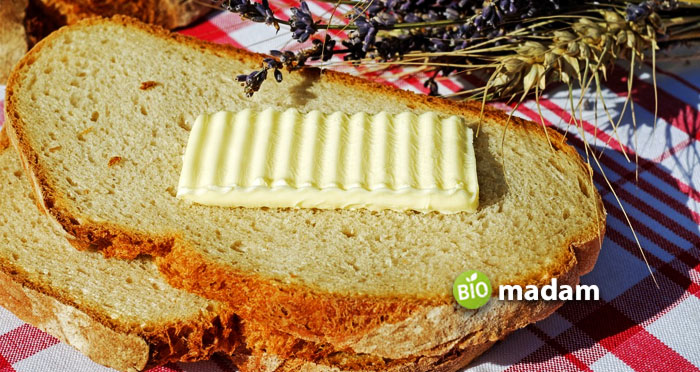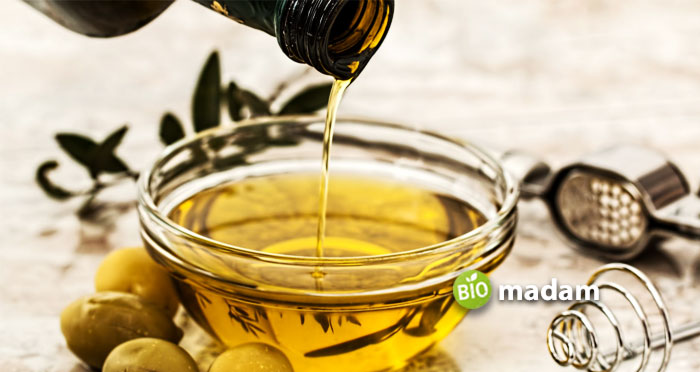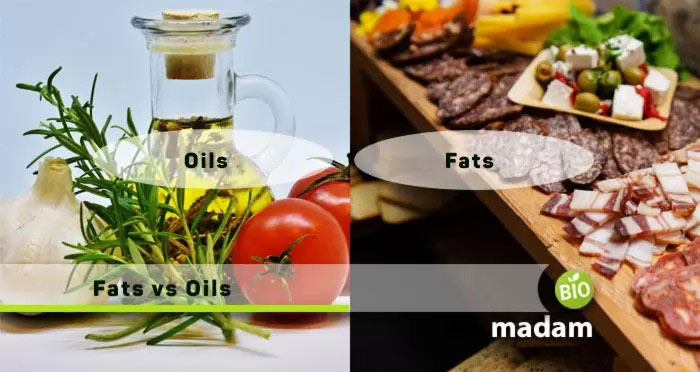Recently updated on March 7th, 2023 at 07:52 am
You may have come across people saying that fats and oils are unhealthy and you should stay away from them.
But did you know that they are one of the essential macronutrients?
Your body needs macronutrients in considerable amounts as they help in many body functions and are a part of normal body growth and development. Oils are a type of fat, and both should be taken in enough amounts as suggested. Fats and oils come from different sources and provide specific nutrients to the body. Besides being from varying sources, there are numerous other dissimilarities between the two.
Let’s talk about fats and oils in detail.
Comparison Table
| Factors | Fats | Oils |
| Physical State | Solid | Liquid |
| Source | Animal | Plant |
| Saturation | Saturated fatty acids | Unsaturated fatty acids |
| Types | Saturated & Trans fats | Monounsaturated & polyunsaturated |
| Cholesterol Status | Increase cholesterol | Improve cholesterol |
| Metabolism | Difficult | Easily metabolized |
| Melting Point | High | Low |
| Rancidity | High | Low |
| Effect on CVS | Increase the risk of CVD | Decrease the risk of CVS diseases |
| Storage | Stored in Adipocyte cells | Stored in seeds and fruit |
| Examples | Cheese, butter | Soybean oil, Chamomile oil |
What are Fats?
Fats are an essential group of elements, like carbon, oxygen, and hydrogen esters joined with glycerol. They possess the same fundamental composition, yet the specific fatty acids and arrangement determine the types. Fats are from animal sources and are present under the animals’ skin. They serve functional and metabolic functions.
Fats are “compounds soluble in organic solvents but insoluble in water and other inorganic solvents.”
Characteristics of Fats
- They are insoluble in water
- Fats come from animal sources
- They are solid at room temperature
- Fats lead to elevated cholesterol if taken beyond the suggested amount

Types of Fats
There are three types of fats; unsaturated fats, saturated fats, and trans fats. Saturated fats are typically solid in form at room temperature owing to the presence of ester linkages. However, unsaturated fats are liquid and are typically called oils. Trans fats are produced industrially by adding other molecules or compounds to produce thick-consistency oils. The types of fats are explained briefly below.
Saturated Fats: Saturated fats are solid and obtained from animal sources. Some types of saturated fats are butter and cheese.
Unsaturated Fats: They are in a liquid state at room temperature and typically come from different plants and fish, and are healthier. Examples of unsaturated fatty acids are canola oil, fish oil, etc.
Trans Fats: Unsaturated fatty acids are infused with hydrogen to thicken and produce partially hydrogenated fats, also called trans fats. They are not much health-friendly, as guided by the American Heart Association.
What are Oils?
Oils are viscous liquids obtained from plants and fish sources. They are liquid at room temperature and easily metabolize. The easy breakdown of oils makes them a preferred choice of fatty acids with low melting points.
Oils are divided into two categories; monounsaturated and polyunsaturated fatty acids. Oils are healthier than fats as they help lower bad cholesterol (LDL) and improve good cholesterol (HDL) levels in the body.
Characteristics of Oils
- Oils commonly come from plant seeds
- They are composed of unsaturated fatty acids
- They are liquid at room temperature
- Oils contribute to improving HDL in the body
- Oils can be converted into partially hydrogenized fats through industrial processes
Types of Oils (Unsaturated Fats)
Unsaturated fatty acids are categorized into two types, considering the type of bonds present in them.
Monounsaturated Fatty Acids: These unsaturated fatty acids have only one double bond. Examples include vegetable oils like peanut oil, canola oil, olive oil, and nut fat.
Polyunsaturated Fatty Acids: They have more than one double bond in their composition. Examples of polyunsaturated fatty acids are soybean oil, sesame oil, corn oil, sunflower oil, etc.

Similarities between Fats and Oils
While they both are different, they also have a few similarities. Some of them are:
- They contain equal calories per gram (9 cal/gm).
- Fats and oils do not dissolve in water.
- They both are lipids and act as energy storage in plants and animals.
Difference between Fats and Oils
Physical State
Fats
Fats are typically solid at room temperature.
Oils
Whereas, oils are usually liquid at room temperature until modified through an industrial process.
Source
Fats
Fats are obtained from animal sources and found under the skin of animals.
Oils
On the other hand, oils are prepared from the seeds of plants. They are also sometimes derived from fish sources.
Composition
Fats
Fats are composed of esters of fatty acids formed by hydrogen, carbon, and oxygen with glycerol. They are saturated fatty acids.
Oils
Whereas, oils constitute fatty acids and glycerol. They are unsaturated fats and thus liquid in the state.
Types
Fats
Fats are categorized into three types. They are unsaturated, saturated, and trans fats. Unsaturated fats are typically oils.
Oils
In comparison, oils are of two types; monounsaturated and polyunsaturated fatty acids.
Cholesterol Status
Fats
They are not considered healthy fatty acids and lead to increased cholesterol.
Oils
On the other hand, oils are healthier than fatty acids as they improve HDL levels and contribute to healthy fats in the body.
Metabolism
Fats
Fats are difficult to break down and accumulate in different body parts, including blood vessels. They may also lead to problems like coronary artery disease.
Oils
Contrarily, oils are easy to metabolize and play their part in body functions quicker.
Melting Point/Rancidity
Fats
Fats have a higher melting point because of their solid consistency and are also more rancid than oils.
Oils
On the opposite, oils have a lower melting point as they are in liquid form and have less rancidity.
Effect on CVS
Fats
Fats increase the risk of cardiovascular diseases by depositing in the arteries.
Oils
Alternatively, they decrease the risk of cardiovascular diseases by being easily metabolized and utilized by the body.
Storage
Fats
Fats are stored in specialized Adipocyte cells in animals.
Oils
On the contrary, plant seeds and fruits are the main storage for oils.
Examples
Fats
Examples of fats include cheese, butter, etc.
Oils
Examples of oils include Soybean oil, Chamomile oil, fish oil, etc.

FAQs
Are fats vital for us?
Fats are macronutrients and play an important role in body growth and development. Taking more fats than the recommended amount can lead to health concerns. Healthcare professionals suggest taking unsaturated fatty acids instead of saturated fatty acids.
Is it okay to intake fats in large amounts?
Fats are composed of saturated fatty acids and are solid at room temperature. Their composition makes it difficult for the body to break into smaller components. Intaking a lot of fats can lead to their accumulation in the blood vessels leading to coronary artery diseases.
Are trans fats considered oil?
Trans fats are not oils as they are converted into a middle-stage form of fats and oils by adding hydrogen gas through industrial methods.
What are monounsaturated and polyunsaturated fatty acids?
Monounsaturated and polyunsaturated fatty acids are types of unsaturated fatty acids (oils). Monounsaturated fatty acids have only one double bond, while polyunsaturated fatty acids have multiple double bonds in their chain.
The Bottom Line
Fats and oils are essential parts of the diet and should be taken in adequate amounts. Doctors recommend adding unsaturated fatty acids (oils) to your diet instead of saturated fats. Both give an equal amount of energy and act as energy stores for plants and animals. Besides other differences in their form and composition, fats may lead to cardiovascular diseases, whereas oils help improve cholesterol levels by increasing HDL in the body.

Anna has completed her degree in Pharmacy from the University of Hawaii. She is serving as a research assistant in a pharmaceutical company. She had a great interest in writing blogs, traveling to different parts of the US, and trying delicious recipes in her spare time.

